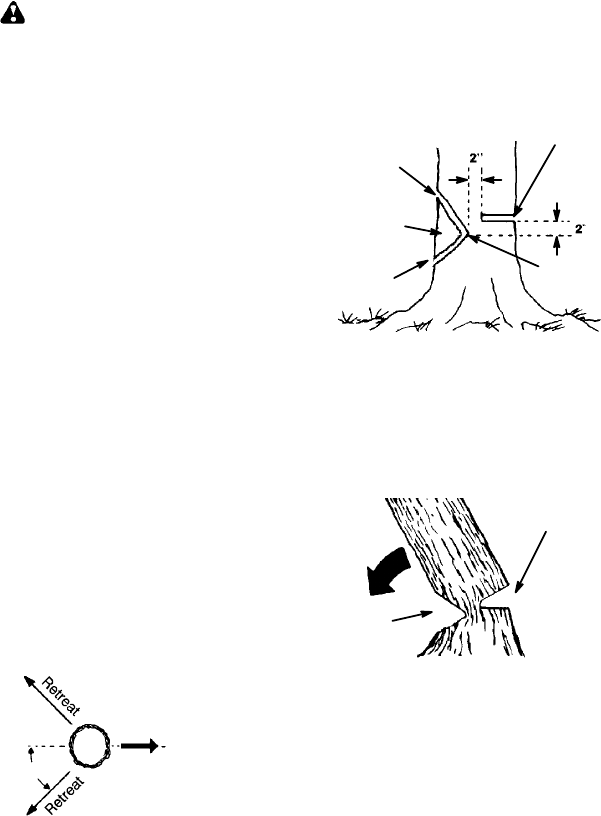
12
S Toavoidlosingcontrolwhencut iscom-
plete,donotputpressureonsaw atend
of cut.
S Stop the engine before setting the saw
down after cutting.
TREE FELLING TECHNIQUES
WARNING: Check for broken or
dead branches which can fall while cutting
causingserious injury. Do notcut nearbuild-
ings or electricalwires ifyou donot know the
directionof treefall, norcutatnight sinceyou
will not be ale to see well, nor during bad
weather such as rain, snow,or strongwinds,
etc. If the treemakes contact with any utility
line, the utility company should be notified
immediately .
S Carefullyplanyour sawingoperationinad-
vance.
S Cleartheworkarea. Youneedacleararea
allaround thetree so you can havesecure
footing.
S The chain saw operat or should keep on
the uphill side of the terrain as the tree i s
likely torollorslidedownhillafterit isfelled.
S Study the natural cond itio ns th at can cause
the tree to fall in a particular direction.
Natural conditions that can cause a tree to
fall in a particular direction include:
S The wind direction and speed.
S The lean of the tree. The lean of a tree
might not be apparent due to uneven or
sloping terrain. Usea plumbor level tode-
termine the direction of tree lean.
S Weight and branches on o n e side.
S Surrounding trees and obstacles.
Look for decay and rot. If thetrunk is rotted,
it can snap and fall t oward the operator.
Check for broken or dead branches which
can f all on you while cutting.
Make sure there is enough room for the tree to
fall. Maintain a distance of
2-1/2 tre e lengths
from the nearest person or other objects. En-
gine noise can drown out a warning call.
Remove dirt, stones, loose bark, nails, sta-
ples, andwire fromthe treewherecuts areto
be made.
Plana clearretreat pathto therear and diag-
onal to the line of fall.
Direction of Fall
45_
Plan a clear retreat path
FELLING LARGE TREES
(6 inches (15 cm) in diameter or larger)
The notch method is used to fell large trees.
Anotchis cutonthe side ofthetreeinthede-
sired direction of fall. After a felling cut is
made on the opposite side of tree, the tree
will tend to fall into the notch.
NOTE: If the tree has large buttress roots,
removethembefore makingthenotch. I fus-
ing saw to remove buttress roots, keep saw
chain fromcontacting groundtopreventdull-
ing of the chain.
NOTCH CUT AND FELLING THE
TREE
S Make notch cut by cutting the top of the
notch first. Cut through
1/3 of the diameter
ofthetree. Nextcomplete thenotch bycut-
ting the bottom of the notch. See illustra-
tion. Once the notch is cut remove t he
notch of wood from the tree.
Notch
First cut
Second cut
Final (felling) cut here, 2 in ches
(5 cm) above center of notch.
Hinge
S After removing the wood from the notch,
make the felling cut on the opposite side of
thenotch. This isdone by makinga cutabout
two inches (5 cm) higher than the center of
the notch. This willleave e nough uncutwood
between the felling cut and the notch to form
a hinge. This hinge will helpprevent the tree
from falling in the wrong direction.
Opening
of felling
cut
Closing of
notch
Hinge holds tree on stump a nd helps
control fall
NOTE: Before felling cut is complete, use
wedges to open the cut if necessary to
controlthedirectionoffall. To avoidkickback
and chain damage, use wood or plastic
wedges, but never steel or iron wedges.
S Be alert to signs that the tree is ready to
fall: cracking sounds, widening of the fell-
ing cut, or movement in the upper
branches.
S As tree starts to fall, stop saw, put it down,
and get away quickly on your planned re-
treat path.
S DO NOT cut down a part ially fallen tree
with your saw. Beextremely cautious with
partially fallen trees that may be poorly
supported. When a t ree doesn’t fall com-
pletely,setthesawasideandpulldownthe
tree with a cable winch, block and tackle,
or tractor.


















